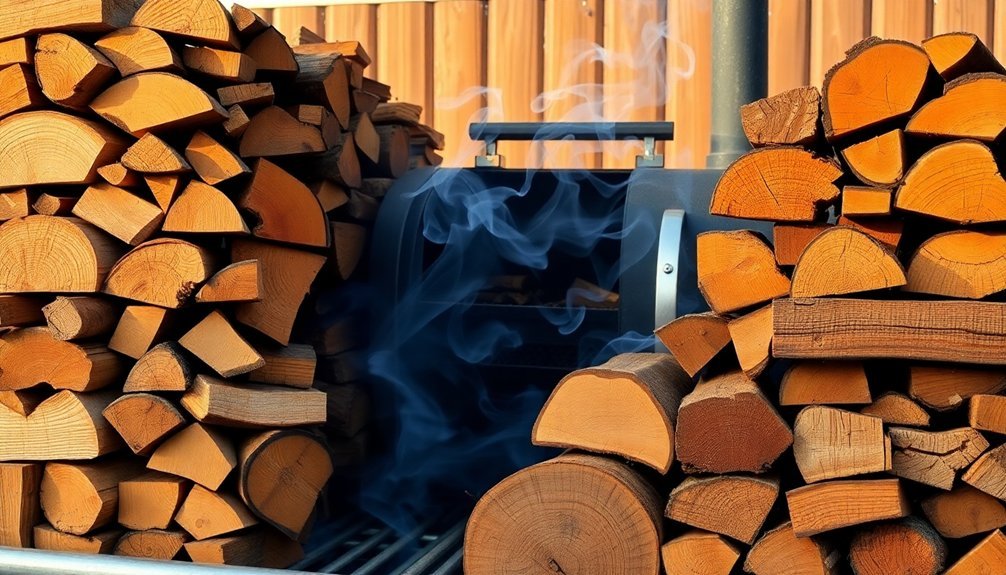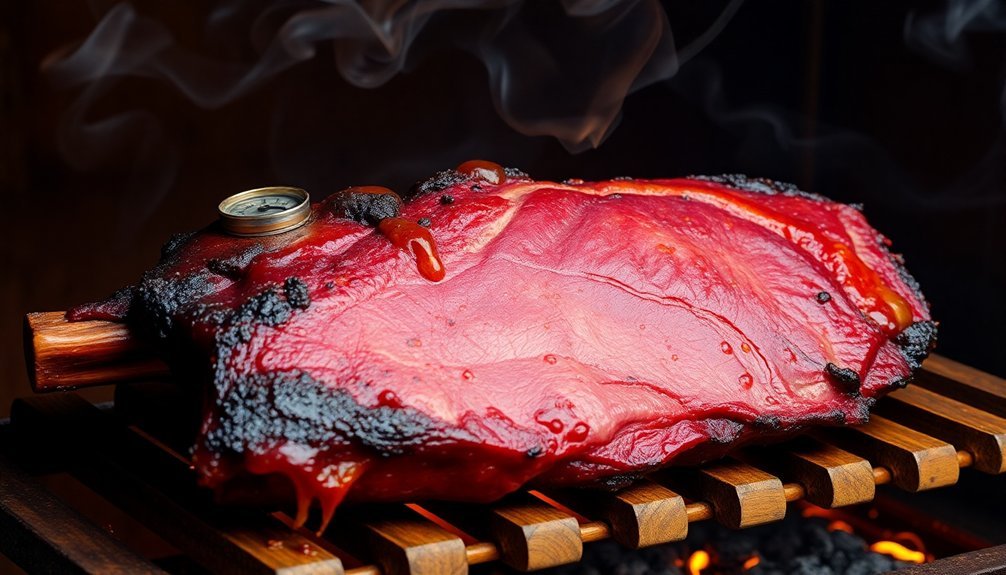To smoke perfect meat, you'll need to master five time-tested methods. Start by selecting the right wood for your meat type – hickory for beef, fruitwoods for poultry. Keep your smoker's temperature steady between 200-250°F using two thermometers for accuracy. Prepare your meat properly by trimming excess fat and applying rubs or marinades, letting them rest for flavor absorption. Maintain clean, thin blue smoke by controlling airflow and using quality hardwoods. Follow safety practices like preventing cross-contamination and monitoring internal temperatures. These foundational techniques will reveal the secrets to mouthwatering, perfectly smoked meats.
Choosing Your Smoking Woods

Anyone can throw wood into a smoker, but choosing the right smoking wood is essential for achieving that perfect barbecue flavor.
You'll want to start by matching your wood to your meat: hickory and oak work beautifully with beef and pork, while maple and fruit woods complement poultry and seafood perfectly. If you're smoking beef brisket, post oak is your Texas-style go-to, while mesquite delivers an intense flavor that's perfect for larger cuts. Cherry wood is especially popular for its light, sweet flavor profile.
Consider the form of wood that suits your smoking method. If you're using an offset smoker, logs or splits will give you that long-lasting burn you need. For shorter cooks, chunks provide consistent smoke for about an hour, while chips work well for quick flavor boosts. If you've got a pellet grill, you'll rely on pellets for their steady smoke output.
Don't forget to follow the fundamental rules: always use hardwoods, avoid softwoods like pine, and soak your chips or chunks before use.
When you're loading your smoker, wait until it reaches the right temperature before adding the wood. This approach guarantees you'll get clean smoke and ideal flavor.
Proper Temperature Control
Mastering temperature control consistently separates great barbecue from mediocre results.
You'll want to maintain your smoker's temperature between 200-220°F for most meats, though some cuts may require temperatures up to 250°F. Using low temperatures allows better smoke penetration into the meat. Keep two accurate thermometers handy – one for monitoring the smoker's internal temperature and another for checking the meat's doneness.
To maintain steady temperatures, keep your smoker's lid closed as much as possible and control airflow using the dampers. You'll need to add charcoal or wood periodically to maintain heat, and placing a water pan inside helps stabilize temperature while keeping meat moist. If you're using charcoal, avoid lighter fluid and opt for a chimney starter instead.
Different meats require specific internal temperatures for safety and tenderness. Cook poultry to 165°F, while most other meats need at least 145°F.
For tender barbecue results, you'll want higher finishing temperatures – aim for 205°F with brisket and 185°F for pork butt.
Remember that factors like meat thickness, humidity, and smoker insulation will affect your cooking time and temperature management.
Meat Preparation Steps

Four essential steps guarantee perfectly smoked meat before it ever hits your smoker. Start by selecting high-quality, fresh meat that's appropriate for your smoking method, making sure you've chosen the right cut for your desired outcome.
Next, trim excess fat and apply your seasonings evenly, whether you're using a dry rub or marinade. Let the meat rest for at least 30 minutes to allow the flavors to penetrate deeply.
Finally, bring your meat to room temperature before smoking to guarantee even cooking and ideal smoke absorption.
Look for cuts with good fat marbling throughout the meat to ensure optimal tenderness and flavor development during smoking.
Proper meat preparation will greatly impact your smoking results. Here are key tips to enhance your success:
- Choose pre-trimmed cuts when possible to save time and guarantee even seasoning distribution
- Apply your rub or marinade generously, making sure to cover all surfaces of the meat
- Store seasoned meat in the refrigerator on a clean plate to prevent cross-contamination
- Allow marinated meats to come to room temperature gradually for all-day smoking sessions
- Let beef and pork reach room temperature before applying rubs for better adherence
Managing Smoke Quality
Creating the perfect smoke quality stands at the heart of successful meat smoking. You'll need to focus on selecting the right wood and managing proper airflow to achieve that signature thin blue smoke that delivers ideal flavor.
Choose hardwoods like hickory, oak, or fruitwoods for your smoking sessions, and avoid softwoods that can release resins and ruin your meat's taste. You'll want to maintain precise control over your smoker's airflow through the vents and dampers to keep the wood burning at the right rate.
| Smoke Type | Characteristics | What It Means |
|---|---|---|
| Thin Blue | Light, almost invisible | Ideal smoking conditions |
| White Billowing | Thick, heavy clouds | Too much fuel or poor airflow |
| Dark Gray | Dense, lingering | Dirty burn, needs adjustment |
| Clear | No visible smoke | Not enough wood or too hot |
| Yellow-Brown | Thick, pungent | Wrong wood type or wet fuel |
To achieve the best results, you'll need to balance both heat and smoke levels throughout the cooking process. Watch for clean, thin blue smoke, which indicates proper burning temperatures and good airflow. When you maintain these conditions, you'll develop that sought-after bark and rich flavor profile in your smoked meats.
Essential Safety Practices

Along with mastering smoke quality, maintaining strict safety practices is vital for successful meat smoking.
You'll need to monitor temperatures constantly, keeping your smoker between 225°F and 300°F while guaranteeing meat reaches safe internal temperatures: 145°F for whole cuts of beef, pork, lamb, and veal; 160°F for ground meats; and 165°F for poultry.
Cross-contamination prevention is essential for food safety. Always use separate cutting boards and utensils for raw and cooked meats, and wash your hands thoroughly before and after handling raw meat.
When marinating, keep meat refrigerated and never reuse marinade that's touched raw meat unless you boil it first.
Here are key safety practices you can't ignore:
- Thaw meat completely before smoking to guarantee even cooking
- Use a reliable thermometer to monitor both smoker and meat temperatures
- Keep raw meat separate from cooked foods during storage and preparation
- Allow meat to rest for at least three minutes after cooking
- Clean your smoker thoroughly between uses to prevent contamination
Remember to track cooking times based on meat type and size, typically calculating about 1.5 hours per pound for items like brisket.
Frequently Asked Questions
How Long Should I Let Smoked Meat Rest Before Cutting?
You'll want to rest your smoked meat for 30-45 minutes minimum, but larger cuts like brisket and pork butt need longer. Let brisket rest for an hour, and pork butt for up to 2 hours.
Can I Reuse Wood Chips That Haven't Completely Burned Up?
You can reuse wood chips that haven't fully burned, but they won't give you the same strong smoke flavor. It's best to use fresh chips since partially burned ones provide less effective smoking and minimal benefits.
What's the Best Way to Clean My Smoker Between Uses?
After smoking, you'll want to remove food debris, empty ash, clean your grates, and wipe down surfaces. Use foil on drip pans to make cleanup easier, and don't forget to clean water and wood chip trays.
Should I Rotate the Position of Meat During Smoking?
You should rotate your meat every 2-3 hours during smoking. It'll help guarantee even cooking and smoke exposure, but don't overdo it – frequent lid opening can disrupt temperature and moisture levels.
Can I Open the Smoker to Spray or Baste the Meat?
You can spray or baste your meat, but limit opening the smoker to every 30-45 minutes. Each opening drops temperature and disrupts smoke flow, so be quick when you do it to minimize heat loss.
In Summary
You'll find smoking meat becomes second nature once you've mastered these fundamental techniques. Select the right wood, maintain steady temperatures, prep your cuts properly, control your smoke flow, and follow safety protocols – that's all you need for consistently perfect results. Whether you're smoking brisket, ribs, or poultry, these time-tested methods will help you achieve that coveted smoky flavor and tender texture every time.





Leave a Reply